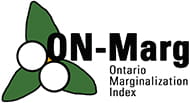
Ontario Marginalization Index (ON-Marg)
ON-Marg is a data tool that combines a wide range of demographic indicators into four distinct dimensions of marginalization. As a multifaceted index, ON-Marg measures multiple axes of marginalization in Ontario, including economic, ethno-racial, age-based and social marginalization.
It can be used for:
- Planning and needs assessment: For example, if the goal is to identify service gaps, ON-Marg can be used to identify where rates of hospitalizations for a particular disease, such as diabetes, are high and additional services might be needed.-
- Resource allocation: For example, marginalization indexes could be used in funding formulae for primary health care services.
- Monitoring of inequities: For example, marginalization indexes can provide a way to monitor changes in areas over time to look for improvement or to identify areas that may be in decline.
- Research: For example, in the health sector there is a long history of using small area indexes to describe the relationship between marginalization and health outcomes; greater marginalization is associated with higher mortality rates and higher rates of many diseases.
About the tool
The 2021 version of ON-Marg was created in collaboration with the MAP Centre for Urban Health Solutions at St. Michael’s Hospital, using data retrieved from the 2021 Canadian census. Data is available at the small area level, as well as larger geographies such as public health units.
After consulting with community groups across Ontario, we changed the dimension names for the 2021 version of ON-Marg. While the dimensions are consistent with previous iterations, the names have been changed to avoid deficit-based language and more closely reflect the census measures that comprise each dimension:
- Households and dwellings (previously called ‘Residential instability’): Includes indicators that measure types and density of residential accommodations, and certain family structure characteristics, such as % living alone and % dwellings not owned.
- Material resources (previously called ‘Material deprivation’): Includes indicators that measure access to and attainment of basic material needs, such as % unemployment and % without a high school degree.
- Age and labour force (previously called ‘Dependency’): Includes indicators to describe % seniors (65+), the dependency ratio (the ratio of seniors and children to the population 15-64) and % not participating in the labour force.
- Racialized and newcomer populations (previously called ‘Ethnic concentration’): Includes indicators to describe % recent immigrants and % who self-identify as a ‘visible minority’ (as defined by Statistics Canada).
Ontario Marginalization Index Map
PHO’s new Ontario Marginalization Index Map (previously the Social Determinants of Health Map) includes the most current ON-Marg 2021 data allowing users to visualize and explore the geographical distribution of marginalization in Ontario. This map supports evidence-based public health in Ontario by promoting understanding of the geographic patterns of marginalization in Ontario and within each public health unit, and enabling conversations about health equity planning. For the best experience and to learn more, please see the ON-Marg Map User Guide.
Historical versions
ON-Marg data is now available for 2001, 2006, 2011 (with Technical Notes), 2016, and 2021 – making it possible to track changes in marginalization and health equity over time, over a 20-year timeframe.
Presentation
Key Publications
About our Partners
MAP Centre for Urban Health Solutions is a world-leading research centre dedicated to creating a healthier future for all. Through big-picture research and street-level solutions, MAP scientists tackle complex community health issues — many at the intersection of health and inequity.



Don’t have a MyPHO account? Register Now

